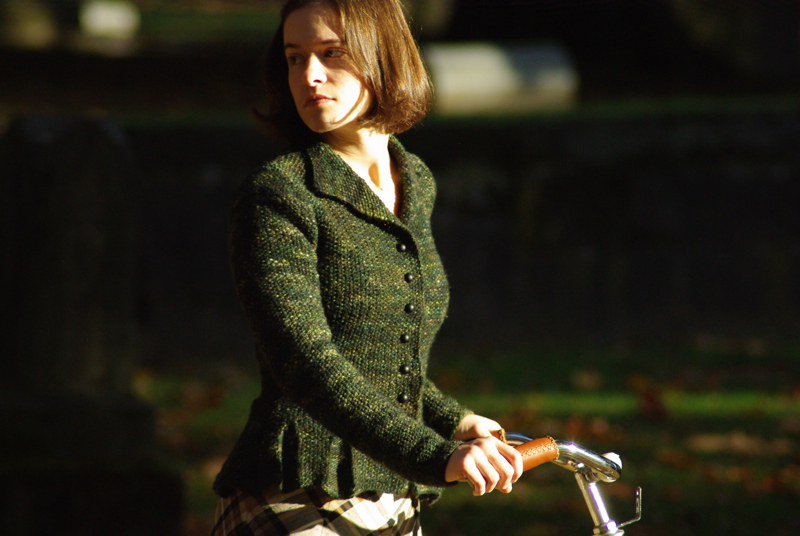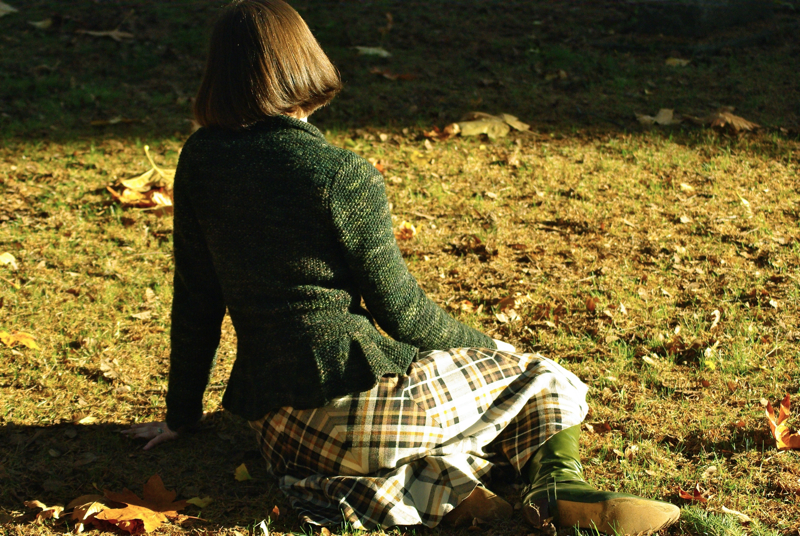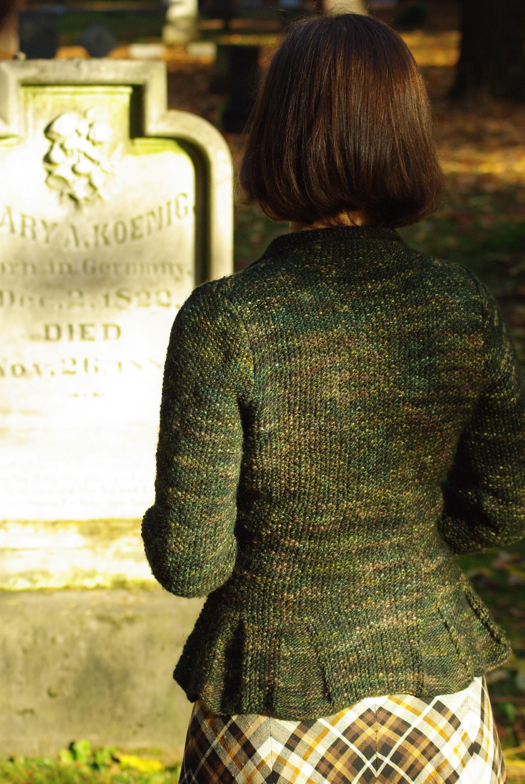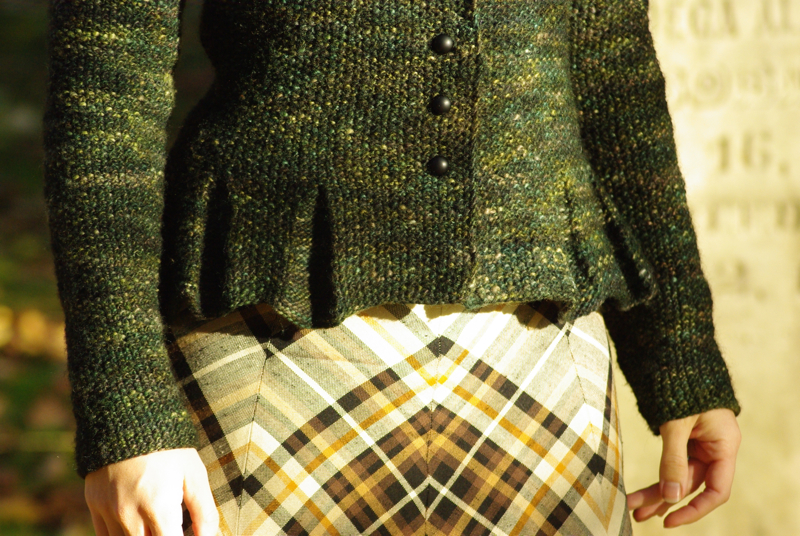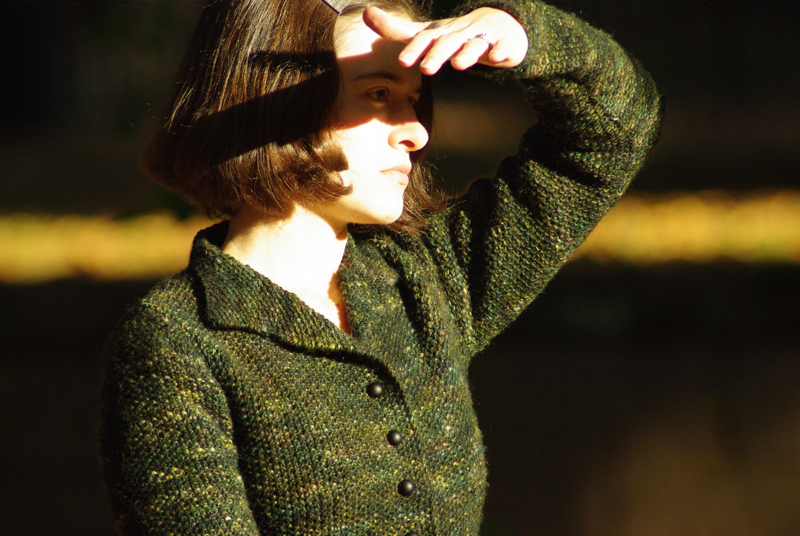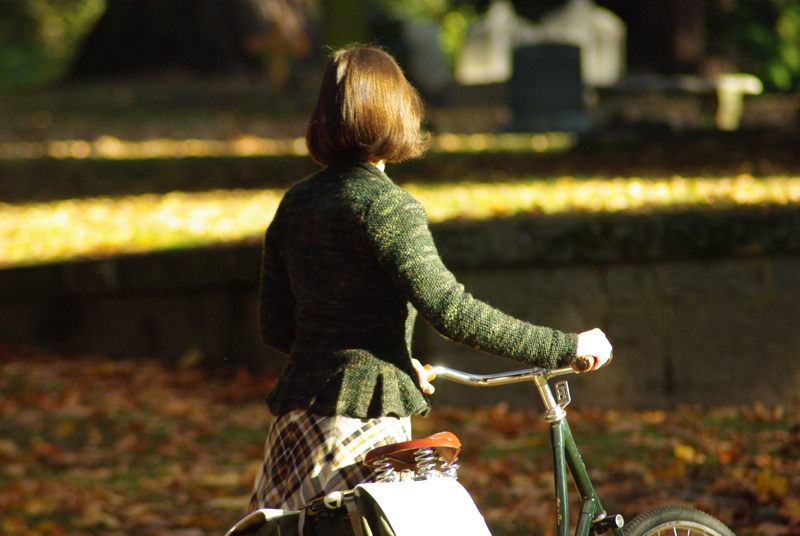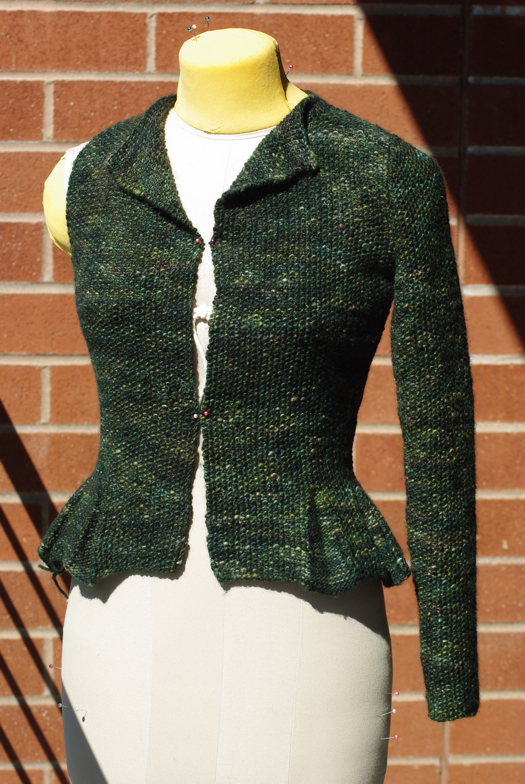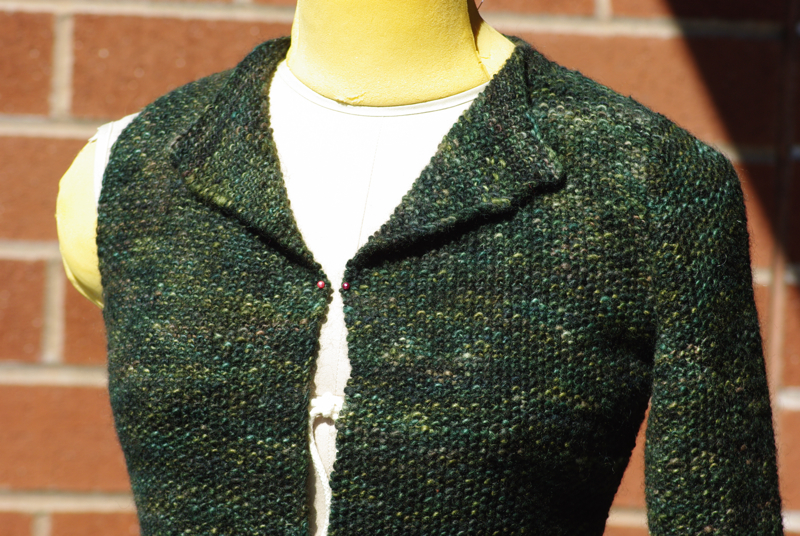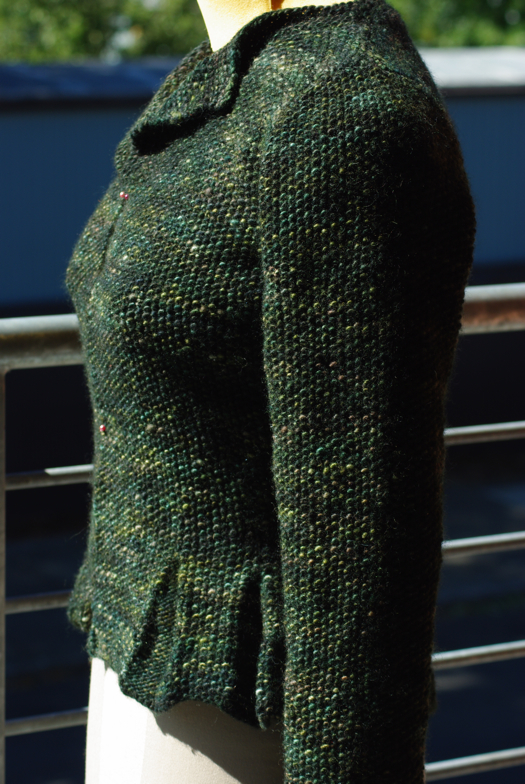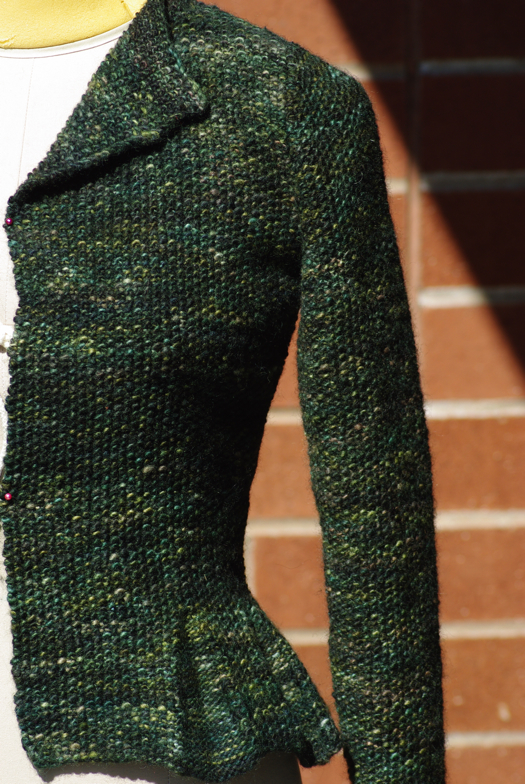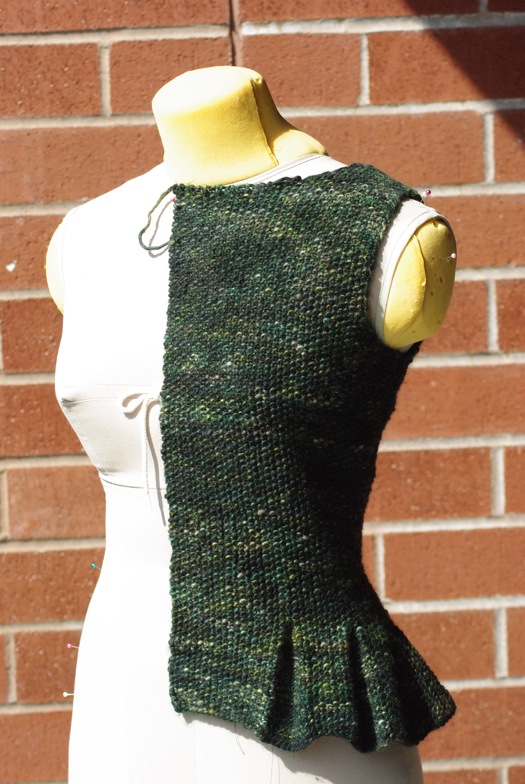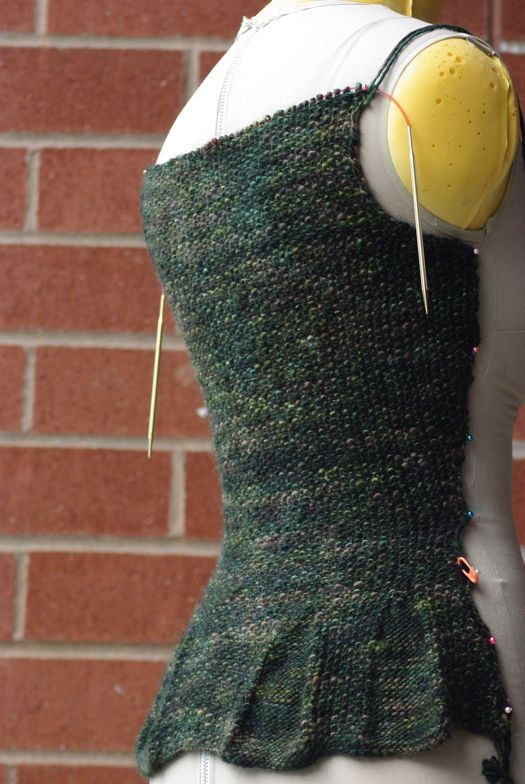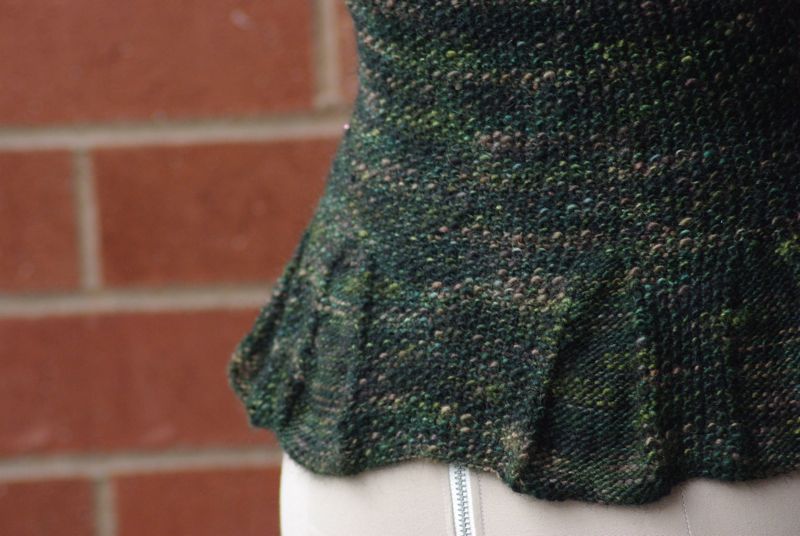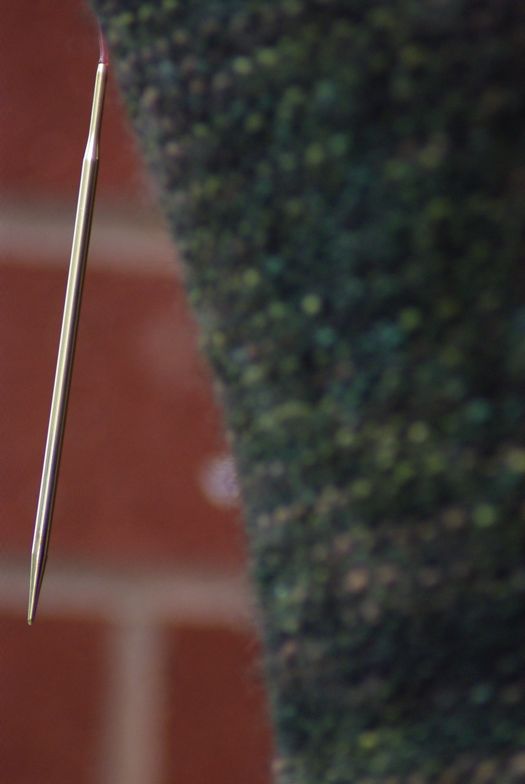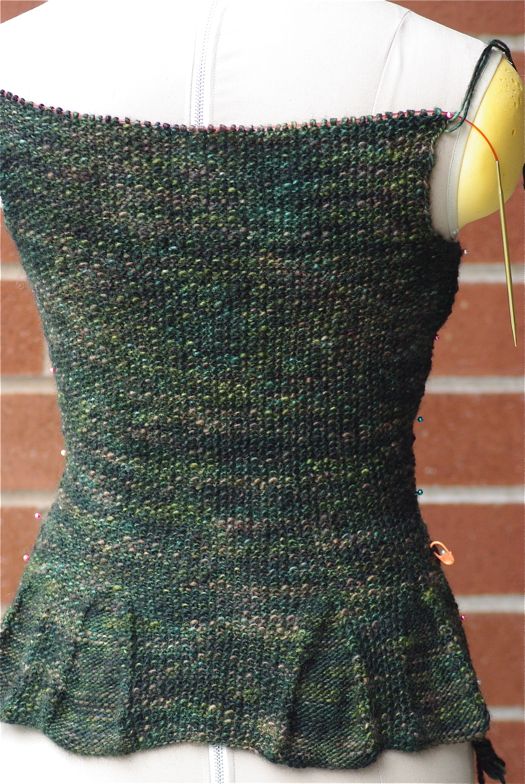Well. David and I are starting to recover from our spate of bad luck, despite ANOTHER anxiety-producing few days in which we had to hospitalize Mr. Bingley in order to help him recover from a gastrointestinal disaster of the first degree. He's home now, back to his good old self, and we're sleeping ten hours a night and spending some well-earned time just vegging out. Which means that my Kim Hargreaves jacket is coming along nicely:
I've been remembering a lot about why I so enjoy her patterns, and I thought I'd do the promised breakdown of Top Five Reasons I Love Kim. I warn you, it gets a little epic.
1. Fit: The absolute most inspiring thing to me about Kim Hargreaves's patterns is her thorough and masterful understanding of fit. Many of her designs aren't showy; they feature simple stitch motifs, and aren't immediately astounding on a technical level. But what really gets me is her evocative garment shapes, and the confidence with which she achieves them. With just a delicately bell-shaped sleeve or a carefully-controlled hemline, she can conjure up a whole story in my mind about the character and time period of the wearer. I think careful attention to fit is the mark of a designer who really takes pride in his or her work, since it doesn't provide the initial "wow!" factor of a showy cable or lace motif. But good fit does make for classic, eloquent garments that stand the test of time. In this particular pattern, I've been impressed with two specific things:
- She doesn't overdo it. The shaped peplum in the back of this jacket looks quite dramatic, yes? But the short-row shaping only adds about an inch to the length of the center back. I would have thought that more of a difference would be required from back to front in order to create that equestrian shape, but as it turns out anything more than an inch would have been overkill. Way to go, Kim.
- At the same time, she's not afraid of dramatic shaping when it's called for. The sides of the peplum here decrease so dramatically that even I, who love waist shaping, was getting a little nervous. But I adore the fit-and-flare look that's emerging, so more points to Hargreaves for knowing when to be subtle and when to be daring.
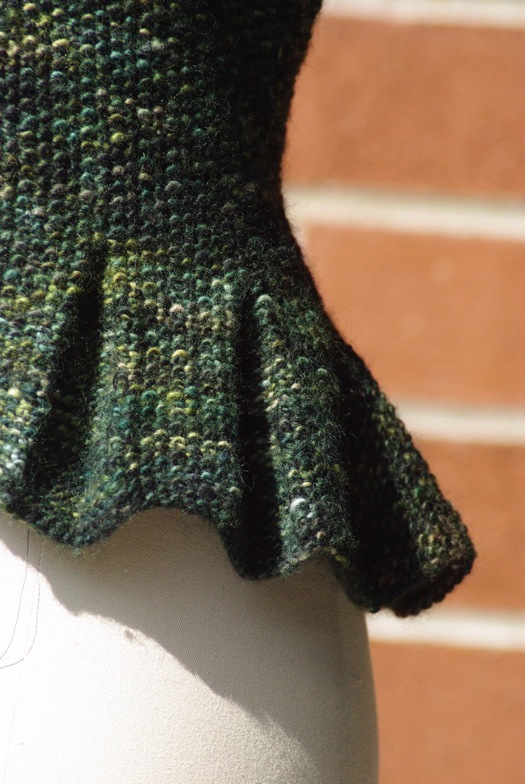
2. Succinct language. This may be controversial, but I LOVE the relatively condensed nature of Hargreaves's pattern instructions. When describing how to set the flounce for the peplum, for example, she writes "moss st X, pX" (where X is the number of stitches). A more beginner-friendly (and American-friendly) way of putting this would be to spell out what she means by "moss stitch": "(K1, p1) 4 times, k1, pX." Similarly, when instructing to increase or decrease for the waist shaping, she writes to "patt to last 2 sts, patt2tog," not specifying what type of decrease she'd recommend using. Although I know that many beginning knitters prefer to have every detail spelled out, I find this condensed style MUCH easier to follow, because it makes the larger pattern more obvious. Working the peplum is actually very easy, conceptually: you just seed stitch x, px, seed stitch x, px, seed st to last 2 sts, decrease 1. Written this way, it's easy to grasp where Hargreaves is going with the pattern: there will be panels of seed stitch alternating with panels of purled stitches, and the purl panels will be gradually decreasing along with the side edges. Written in a clunkier, more expanded fashion, the pattern might be easier for novices to follow along note-by-note, but it would be much more difficult to grasp the larger picture of WHY the designer wants you to work these particular stitches - and that, in turn, makes it harder to spot and correct mistakes. I think this is a complicated issue, and I myself try to err on the side of providing more information rather than less. I certainly want to encourage beginning knitters, rather than alienate them. But I also think there is a place for patterns developed with the more advanced knitter in mind, and that the best way to write them is in this kind of condensed, big-picture language.
(As a side-note: I do think that the pattern would have benefited from a definition of "moss stitch" in a pattern note, since Americans define that stitch differently than Brits.)
3. Attention to detail. At the same time, Hargreaves's ability to communicate the larger plan never means she's neglecting important details. For example, she notes in the peplum directions that, when beginning a moss/seed stitch section, the knitter should always start with the same stitch that ended the last seed section (for example, if you ended the last seed panel with a purl stitch, you should start the next seed section with a purl stitch as well). This is because, when you get to the top of the purl panels and are about to pattern 3 together to make their upper point, you want the resulting stitch to meld seamlessly into the seed stitch body. In order for this to happen, it has to be surrounded by two stitches of the same type, so that you end up with either k-p-k or p-k-p, rather than, for example, k-p-p. I love that she describes how to ensure this result in a general pattern note, rather than figuring out whether each specific size should start on a knit or a purl stitch and thereby complicating the instructions. The end result combines ease of understanding with elegance of language. Brava!
Another pleasing little detail can be found in the decreases of the purl panels: Hargreaves has the knitter p2tog, then work to the last two stitches in the panel and p2tog through the back loop. This is such a satisfying, knitterly detail; working another plain p2tog would look nearly identical from the right side of the fabric, but from the wrong side her directions create two beautifully symmetrical lines of decreases to the left and right of each stockinette triangle.
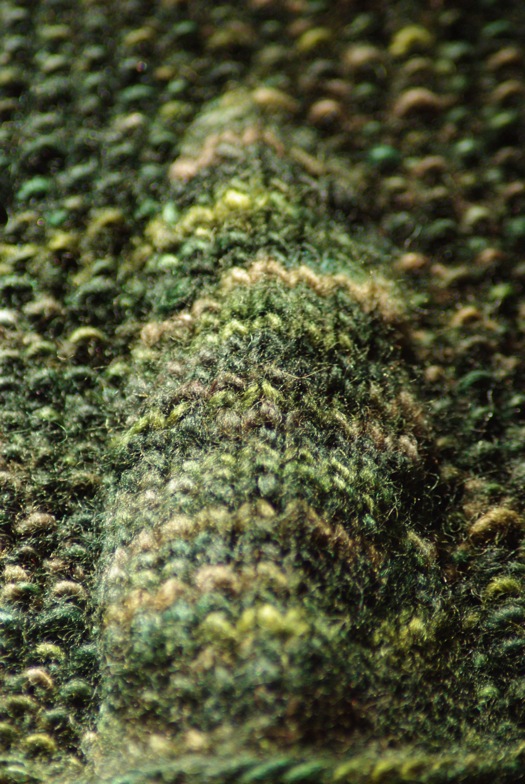
4. She is not afraid of finishing. Here comes another possibly controversial statement: I think the knitting world has become too wary of finishing. Top-down raglans are all very well, and I know that people are scared of seaming. But y'all, it's time to face your fears, because finishing is your friend. Most Hargreaves designs feature bottom-up constructions complete with side-seams - a method that has come to seem somewhat old-fashioned in this era of top-down seamless mania. And you know, there are great things about other construction methods, but I feel strongly that IN GENERAL, seams make a huge difference in how well a garment stands up to wear and tear over time. This is especially true for fat folks or people with big frames. Seams help a garment keep its shape, prevent it from stretching out, and help define its borders to begin with. I applaud designers that continue to use them, and knitters who are willing to learn how to make them.
And finishing is not just about seaming. Rowan and Kim Hargreaves both provide blocking and seaming instructions in the appendices of their collections, and Hargreaves is not afraid of designs that require precision blocking. Honestly, those peplum flounces looked pretty wonky before a solid, multi-part steam block. (I steam-pressed the curl out of the reverse stockinette sections, then folded the fabric along both seed/stockinette boundary lines, with the reverse-stockinette section folded inside, and steam blocked the folds in place, once from each side. For less crisp, more rounded look, I would then hang the garment up and steam the folds until they soften up, but steam wouldn't help if I hadn't done the initial blocking.) Not to sound too preachy, but if there's any set of techniques I would strongly encourage all knitters to learn, it's finishing: it really does make the difference between a durable, polished-looking garment and...one that's not. :-) And I admire Hargreaves for making the most of creative finishing applications, as I think it's an area ripe for exploration.
5. The details of her aesthetic. Having taught myself to knit with Kim Hargreaves designs (specifically Rowan's Vintage Knits), I was kind of shocked when I moved to other designers and started encountering such developments as the bulky rectangular tunic and the 10-inch armhole. I know I'm hopelessly old-fashioned, but for myself (not passing judgment on anyone else's preferencs), I prefer styling details often associated with mid-century vintage: high armholes (I like 8 inches or even 7.5), a tailored silhouette, close waist shaping, not a lot of positive ease. I'm relatively short, so eliminating extra fabric side-to-side makes the most of what limited height I've got, and I'm always a sucker for vintage charm. This isn't a benefit unique to Kim Hargreaves: everyone has their own favorite designer, whose sizing measurements and styling details match up with the look each knitter is chasing. But whoever that is for you (and for me it's Hargreaves), it's such a luxury to have found them, and feel confident that other patterns of theirs are likely to live up to your expectations.

